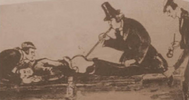Almost makes me want to try and get my old Tuffbook fired up again and get my nerd on. I've got my excel spreadsheets on it and only it, unfortunately.
Tire pressures are probably the biggest area that amateur racers screw up resulting it wild swings in tire performance.
Sounds like drag racing might be a slightly different approach temp/pressure wise, maybe similar to dirt oval stuff in that diameter and tire spring rate are the target more so than target temp/pressure.
On club racing road course and paved oval, I saw it over and over, "35 psi is my starting pressure" so they reset every session back to that same 35 psi they used for the first session at 8:00am when it was 40 degrees out. It's now noon 80f and 2 left tires are in the sun, 2 on the right are in the shade. 35 psi isn't the the same 35 psi as it was in the morning and the 35 psi on the right is not the same as the 35 psi on the right.
It's all about hot Temps and pressures, in the above scenerio the pressures could be off by 8 psi overall and 3-4 psi side for side.. (just made up numbers, not maths)
Using a pretty basic spreadsheet with tire volume and gas law you can hit you target hot temps reliably, every session even with 2 in the shade and 2 in the sun and a 20f swing through the day. Cold pressures are entirely based on the temperature of the core of the tire, not the surface of the tire or the air temp.
I'll save it for another rant but infra-red temp gauges are absolutely shit for tires, maybe somewhat acceptable for hot temps in pit lane IF (big if) the inlap was hot and you are boxed close to pit entrance. Tires want to be probed, deeply. 😁

